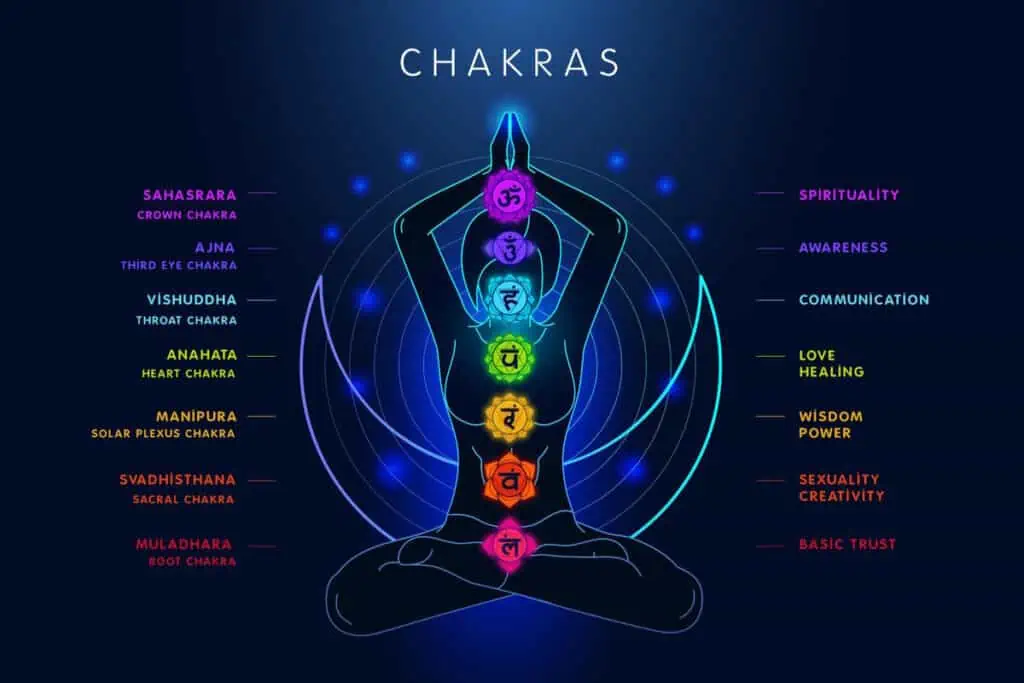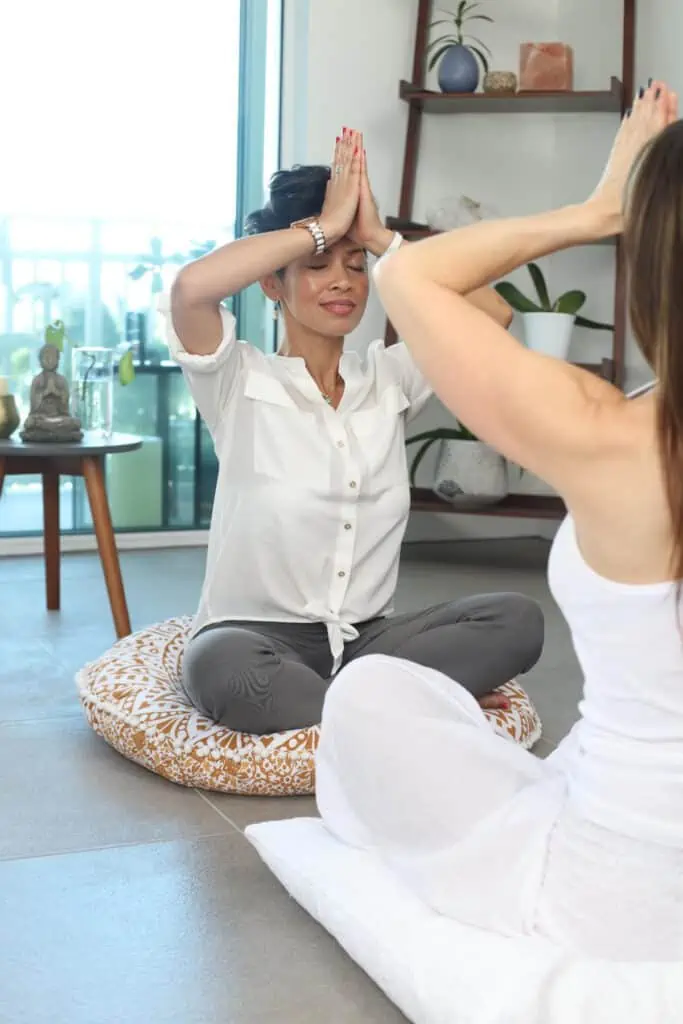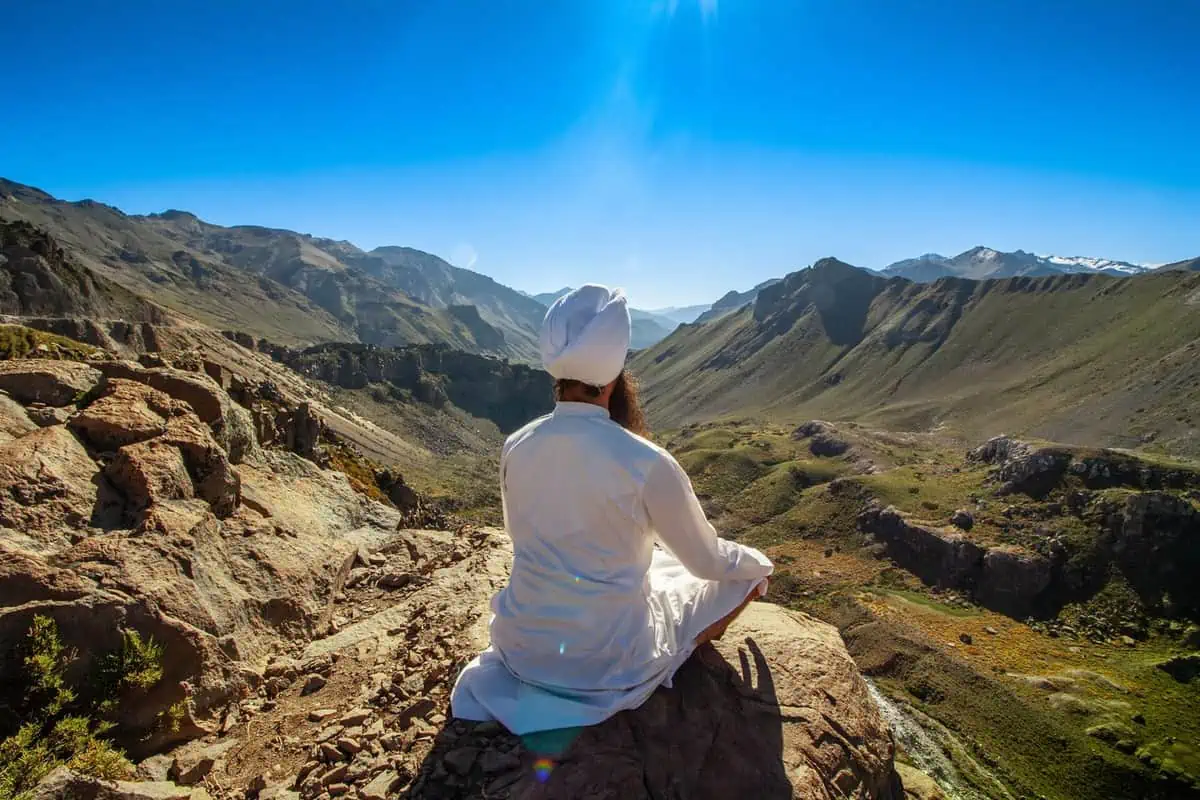If you’re new to yoga, it’s easy to become overwhelmed with all the different styles of yoga classes and popular buzzwords like Hatha, Vinyasa, or Kundalini. But what is Kundalini Yoga? If you haven’t tried it before, you could be missing out on a wonderfully transformative style of yoga that enables you to reach new heights of introspection and self-awareness.
This distinctive style of yoga, introduced to the Western world by Yogi Bhajan in the late 1960s, has captivated many individuals with its combination of physical poses and spiritual rituals. Over the next half century, it gained widespread popularity and has encouraged countless people worldwide to explore the more spiritual side of a yoga practice.
Kundalini Yoga distinguishes itself from other forms of yoga by awakening the dormant energy within us. It progresses beyond physical poses and offers a comprehensive approach to uniting the body, mind, and soul.
This blog will not only help answer the question: What is Kundalini yoga? We will explore the complexities and mysticism of this practice. From understanding the chakras involved in Kundalini awakening to learning about breathwork and other techniques specific to this style of yoga, we’ll cover all you need to know to embark on the esoteric journey into Kundalini.
Contents
- 1 What Is Kundalini Yoga: Its True Essence
- 2 The Spiritual Voyage of Kundalini Awakening
- 3 Exploring Kundalini Yoga Practices
- 4 Benefits & Possible Risks of Practicing Kundalini Yoga
- 5 Clothing & Accessories for Your Practice
- 6 Embarking on Your Kundalini Yoga Journey
- 7 Frequently Asked Questions about Kundalini Yoga
- 8 Final Thoughts
What Is Kundalini Yoga: Its True Essence
Kundalini yoga is an ancient spiritual practice brought to the Western world by Yogi Bhajan. It uniquely combines physical postures, breathing techniques, and mantra chanting. Its primary focus is awakening our innate “Kundalini Shakti,” the Sanskrit word for “serpent power” or dormant spiritual potential.
The goal is to bring positive energy to our lives and to connect with our highest selves.
What to Expect in a Typical Kundalini Yoga Class
To help you feel prepared for your first Kundalini experience, let’s look at what you should expect from this type of yoga class. A typical class in the style of Kundalini yoga consists of six distinct parts:
- “Tuning in” with an opening chant.
- Pranayama, or specific breathing techniques.
- Kriya: a set of yoga poses that opens the body’s energetic pathways.
- Savasana: a time of deep relaxation to let the body rest while the spirit rejuvenates.
- Closing meditation might consist of a repeated mantra or a guided meditation centered on a specific topic.
- Closing chant, such as the Sat Nam mantra.
As you begin your exploration with Kundalini, remember that proper understanding goes beyond mere intellectual knowledge; it requires direct experiential learning. Additionally, the tantric traditions in this practice are explicitly designed for ordinary people leading regular lives, making it accessible even in today’s fast-paced world.
Now you know what to expect externally from your first Kundalini session. But what is the internal process like? Let’s continue even deeper into our discovery of the Kundalini Shakti energy within.
The Spiritual Voyage of Kundalini Awakening
This spiritually-focused style of yoga aims to activate the divine energy known as Kundalini, believed to exist at the base of your spine, like a coiled snake. Regular practice can awaken this dormant spiritual power and guide it upwards through various energy centers called chakras.
The Importance of Chakras in Kundalini Yoga

Understanding the role of the body’s seven primary chakras or energy centers is crucial for experiencing the benefits of an energy-based practice like Kundalini yoga. The chakras play a significant role in promoting both physical and mental well-being.
Muladhara, or the root chakra, lies at the foundation and is associated with grounding and stability. Below the navel, we find Svadisthana, known as the sacral chakra, which relates to creativity and emotional balance. Moving further up, Manipura, located at your solar plexus region, deals with personal power.
Continuing our journey upwards, we encounter Anahata, the heart chakra that governs love and compassion. Vishuddha follows suit as the throat chakra, responsible for communication and truthfulness.
Ajna represents the third eye chakra associated with intuition and wisdom. Finally, we reach Sahasrara, the crown chakra connecting us to pure consciousness.
Understanding these intricate energy networks requires an intimate knowledge of oneself through dedicated practice. Embarking on this enlightening path can lead us toward self-realization, a goal cherished by many spiritual practices such as yoga.
Now that you understand this practice’s energetic foundation, we’ll explain in further detail the essential components of the Kundalini yoga tradition.
Exploring Kundalini Yoga Practices
The experience of a traditional Kundalini session is genuinely immersive, combining various elements to create balance in the mind, body, and spirit. Expect to practice physically energizing asanas like Cobra Pose and spinal twists. In addition to these Kundalini poses, the practice incorporates pranayama (breathing exercises), mudras (hand positions), and mantras (repeated words or phrases used in meditation).
Kundalini Breathing Practices
Kundalini yoga places great emphasis on breathwork, which forms the foundation of the practice. Different breathing techniques, such as alternate nostril breathing (Nadi Shodhana), balance the body’s energies. This specific breathing practice may improve cognitive function and reduce anxiety levels. It involves inhaling through one nostril while closing off the other with your fingers, then alternating sides during exhalation (follow this short tutorial video to try it yourself).
Aside from alternate nostril breathing, your instructor may guide you through techniques like Breath of Fire or Kapalbhati (rapid diaphragmatic breathing) and Long Deep Breathing or Dirgha pranayama. Each specific breathing exercise serves a unique purpose to shift energy within the body during a Kundalini practice.
Using Mudras and Matras Enhance Your Kundalini Practice

Mudras also play an essential role in this ancient discipline by utilizing specific hand gestures to direct energy flow within our bodies. For example, Gyan Mudra – where the thumb touches the index finger – is often used during meditation sessions to enhance mental clarity.
In addition to physical postures and breath control, chanting an opening mantra at the beginning of each session helps us connect with our higher consciousness and set our intentions for practice.
The deep vibrations created by these chants profoundly impact our inner selves, helping us establish a deeper connection with our higher power.
A Meditative Practice
In Kundalini classes, the session usually ends with relaxation and some time for meditation. This part of the session allows practitioners to process their experiences and smoothly transition back into their daily routine.
Allowing this time for integration is crucial to Kundalini and demonstrates its holistic approach to well-being.
Thus far, you’ve discovered several ways Kundalini yoga enhances your overall health. But you might be wondering – are there any disadvantages? Keep reading to learn more about the advantages and possible drawbacks of beginning a Kundalini yoga practice.
Benefits & Possible Risks of Practicing Kundalini Yoga
When practiced correctly under the guidance of an experienced yoga teacher, Kundalini yoga can offer numerous benefits to your physical, psychological, and emotional health.
Mental and Emotional Well-being Through Kundalini Yoga
For people with generalized anxiety disorder, Kundalini yoga can be a source of relief. A study conducted with college women demonstrated that regular sessions over sixteen weeks reduced generalized anxiety and increased feelings of well-being.
Moreover, Kundalini yoga has been scientifically proven to bolster cognitive performance. In a controlled trial of elderly subjects, researchers noted changes in the brain that improved executive functioning after just twelve weeks. This suggests that Kundalini yoga might be an effective strategy to prevent cognitive impairment as we age.
Lastly, Kundalini yoga encourages body positivity. Research hosted by the National Agricultural Library reveals that Kundalini yoga fosters acceptance of our bodies, promoting positive mental health and body image acceptance. Self-love is yet another beautiful side effect of awakening your Kundalini energy!
Is Kundalini Yoga Safe?
Now that you realize the intense power behind Kundalini energy, you might wonder: Is this type of yoga safe?
Under the guidance of a trained instructor, Kundalini yoga is entirely safe for most people. Just communicate immediately with your yoga teacher if discomfort arises during the session.
For instance, you might become dizzy or light-headed in certain pranayama practices, such as the popular breathing exercise Breath of Fire. If this happens, alert your instructor about how you’re feeling, and they might suggest a more fundamental and mild breathing practice.
Using proper techniques and setting clear intentions is crucial to avoid discomfort or intense emotional reactions during or after a session. You must practice in a safe space where you feel supported by a trusted instructor and can properly release excess energy to avoid becoming unbalanced.
When evaluating the safety of Kundalini yoga, we would be remiss not to mention the controversies surrounding Yogi Bhajan, the man credited with introducing Kundalini to the Western world, and the accusations brought against him.
The Controversial Legacy of Yogi Bhajan
Yogi Bhajan’s legacy in modern kundalini practices carries a controversial undertone due to various allegations against him for misconduct. Though considered a divine teacher of yogic practices, the claims against him have sparked concerns about his teachings and methods.
An independent investigation carried out by An Olive Branch Report examined these allegations. This report provides a comprehensive understanding of the controversies surrounding this influential figure in the history of Kundalini Yoga.
Despite its controversial introduction to Western society by Yogi Bhajan, Kundalini Yoga continues to thrive due to its potential for transformation among practitioners.
Thus far, you’ve learned all about the foundations of Kundalini yoga, its numerous benefits, and what to expect from a typical class. Another critical part of a successful Kundalini session involves your environment and how you prepare yourself. So, let’s dig deeper into how you can set yourself up for effective practice.
Clothing & Accessories for Your Practice
Getting the most out of your Kundalini session requires carefully considering what you wear. Traditionally, yogis wear white clothing as this color relates to expanding one’s aura and repelling negative energy.
Aside from the color of your outfit, comfort should be a top priority! Opt for clothing that allows ample room for movement during intricate postures (such as these comfy pants that conveniently come in color white). Additionally, select fabrics that promote breathability to accommodate fluctuations in body temperature throughout the session.
Some yogis also prefer to wear white head coverings as part of their practice. The choice of covering your head in Kundalini yoga goes beyond aesthetics – it can help focus and channel the energy generated at the crown chakra.

Why Your Choice of Yoga Mat Matters
When practicing Kundalini yoga, you must consider the significance of a good quality mat. Optimally, your mat provides essential cushioning and stability on different surfaces while performing asanas. A high-quality, non-slip yoga mat provides cushioned support during postures and ensures stability throughout your session, especially during seated meditation.
Purchasing a good quality mat (like these by Manduka) is well worth the investment – your body will thank you later! If sustainability is important to you, check out our article discussing various factors to consider when selecting mats, such as thickness, durability, traction, texture, and eco-friendliness.
Mindful Choices For a Fruitful Journey
Your choices regarding what you wear or the equipment you use during Kundalini sessions have physical and energetic implications. Whether choosing between cotton or synthetic fabrics, selecting specific colors, considering head coverings, or picking suitable yoga mats – each decision contributes to creating an environment that supports a profound spiritual experience.
Now that we’ve covered everything related to preparing yourself externally with appropriate clothing choices and accessories, you can begin your transformative journey in Kundalini yoga.
Embarking on Your Kundalini Yoga Journey
Beginning your Kundalini yoga journey requires the guidance and support of an experienced teacher. They will usher you through essential techniques and safety measures for a safe and meaningful practice.
Finding the right instructor might initially seem challenging, but plenty of resources are available to help you. Consider enrolling in classes at a center affiliated with the Kundalini Research Institute or exploring local studios that offer Kundalini sessions.
Maintaining a Dedicated Practice
Consistency in your practice is crucial for optimal results in Kundalini yoga. Remember, you might not experience an “A-Ha!” moment immediately. But over time, you will undoubtedly feel a shift in your internal energy as you become more grounded and connected to your higher power.
Dedicate specific times each day to practice, and stick with it. Keep an open mind and embrace your own unique experiences without comparing or judging them, as each person’s journey to personal growth is meaningful and rewarding in its own way.
Frequently Asked Questions about Kundalini Yoga
What is the purpose of Kundalini yoga?
Kundalini Yoga aims to awaken the dormant spiritual energy within, fostering self-awareness and boosting physical vitality. It combines meditation, chanting mantras, and specific poses to create a holistic mind-body experience.
Is Kundalini yoga suitable for beginners?
Yes, with guidance from an experienced instructor, beginners can safely practice Kundalini yoga. Starting with simple breathing exercises and basic postures helps establish familiarity before progressing to more intricate sequences.
Are there contraindications specific to Kundalini Yoga?
No, anyone can engage in Kundalini Yoga regardless of age or fitness level, similar to most styles of yoga. However, individuals with specific health conditions should consult their healthcare provider before starting any new exercise routine.
What does it feel like to experience Kundalini energy?
The awakening of Kundalini often manifests as a powerful surge of energy coursing through the body. Some might describe it as “tuning in” to their higher self. When appropriately guided through the practice, this transformative experience can lead to heightened awareness and profound inner peace.
Is wearing white clothing required for awakening Kundalini Shakti energy?
While you might see some practitioners wearing white, it is unnecessary to experience this ancient yoga practice. Simply wear something comfortable that allows you to focus more intently on your inner experience.
Final Thoughts
Exploring the realm of Kundalini Yoga is a profoundly fulfilling journey, unveiling its ancient origins and highlighting the spiritual potency of its practice. Engaging in this style of yoga goes beyond mere physical exercise; it encompasses a holistic approach to awakening dormant energy within us.
While there are potential benefits such as enhanced cognition and reduced stress, you must be mindful of adverse effects if you do not practice Kundalini with proper intention. Luckily, we’ve shared many tools and techniques you can use to set yourself up for an effective Kundalini practice.
If you’re eager to delve deeper into yoga practices like Kundalini Yoga or explore other aspects of spirituality like chakras, meditation, or crystals, we’ve got you covered here at The Yoga Nomads. Our platform provides comprehensive resources on these subjects, in addition to athletic wear and gear ideally suited for your yogic journey. Embrace the path toward inner peace today!


